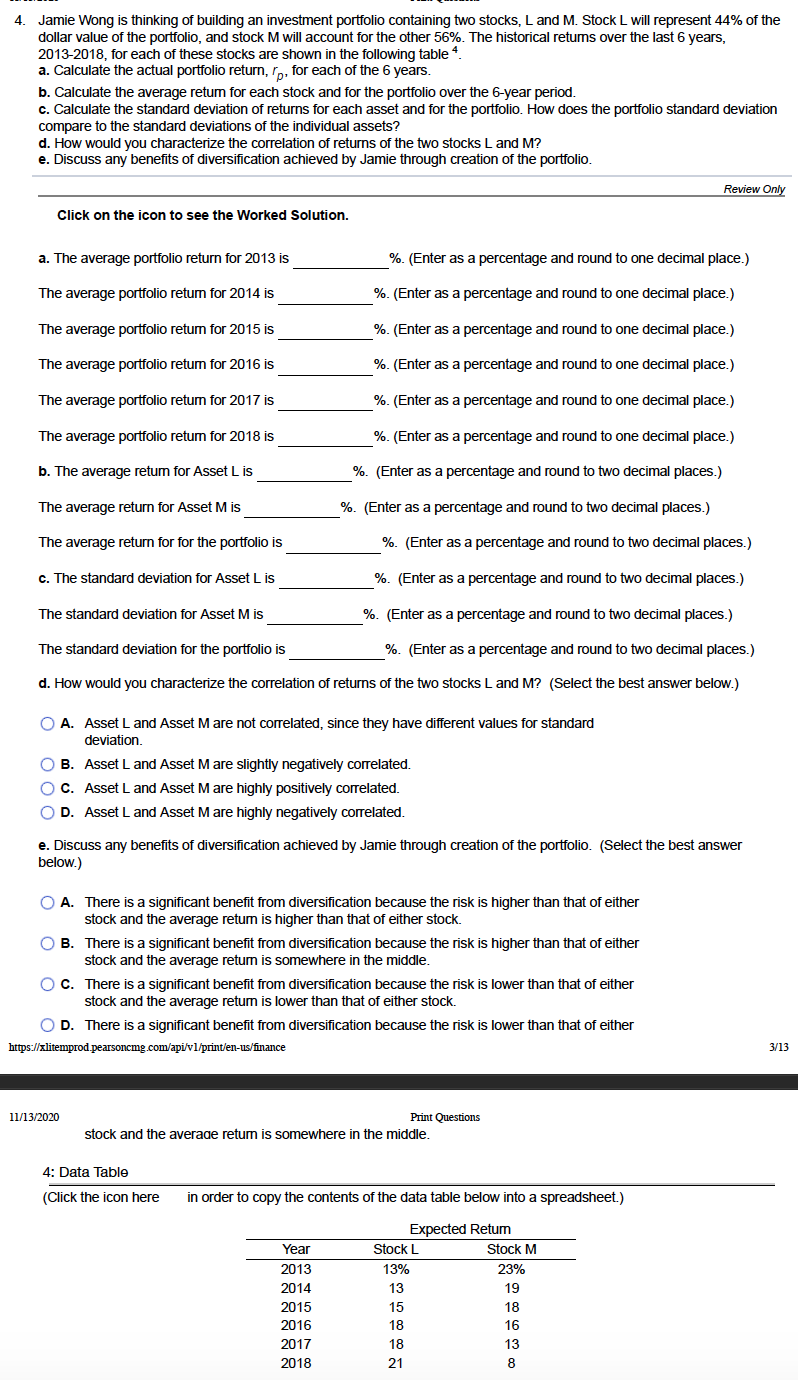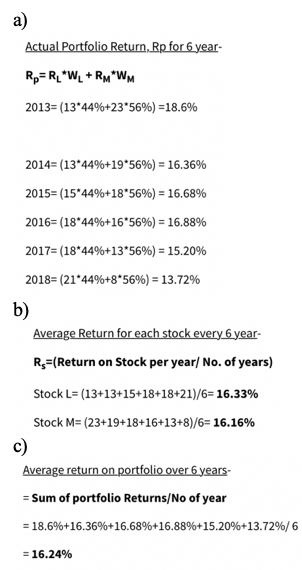c. Calculate the standard deviation of returns for each asset and for the portfolio. How does the portfolio standard deviation compare to the standard deviations of the individual assets? d. How would you characterize the correlation of returms of the two stocks L and M? e. Discuss any benefits of diversification achieved by Jamie through creation of the portfolio.
c. Calculate the standard deviation of returns for each asset and for the portfolio. How does the portfolio standard deviation compare to the standard deviations of the individual assets? d. How would you characterize the correlation of returms of the two stocks L and M? e. Discuss any benefits of diversification achieved by Jamie through creation of the portfolio.
Chapter8: Risk And Rates Of Return
Section: Chapter Questions
Problem 7PROB
Related questions
Question
Parts C, D, and E

Transcribed Image Text:4. Jamie Wong is thinking of building an investment portfolio containing two stocks, L and M. Stock L will represent 44% of the
dollar value of the portfolio, and stock M will account for the other 56%. The historical retums over the last 6 years,
2013-2018, for each of these stocks are shown in the following table 4.
a. Calculate the actual portfolio return, rp, for each of the 6 years.
b. Calculate the average retum for each stock and for the portfolio over the 6-year period.
c. Calculate the standard deviation of returns for each asset and for the portfolio. How does the portfolio standard deviation
compare to the standard deviations of the individual assets?
d. How would you characterize the correlation of returns of the two stocks L and M?
e. Discuss any benefits of diversification achieved by Jamie through creation of the portfolio.
Review Only
Click on the icon to see the Worked Solution.
a. The average portfolio return for 2013 is
%. (Enter as a percentage and round to one decimal place.)
The average portfolio retum for 2014 is
%. (Enter as a percentage and round to one decimal place.)
The average portfolio retum for 2015 is
%. (Enter as a percentage and round to one decimal place.)
The average portfolio retum for 2016 is
%. (Enter as a percentage and round to one decimal place.)
The average portfolio retum for 2017 is
%. (Enter as a percentage and round to one decimal place.)
The average portfolio retum for 2018 is
%. (Enter as a percentage and round to one decimal place.)
b. The average retum for Asset L is
%. (Enter as a percentage and round to two decimal places.)
The average return for Asset M is
%. (Enter as a percentage and round to two decimal places.)
The average return for for the portfolio is
%. (Enter as a percentage and round to two decimal places.)
c. The standard deviation for Asset L is
%. (Enter as a percentage and round to two decimal places.)
The standard deviation for Asset M is
%. (Enter as a percentage and round to two decimal places.)
The standard deviation for the portfolio is
%. (Enter as a percentage and round to two decimal places.)
d. How would you characterize the correlation of returns of the two stocks L and M? (Select the best answer below.)
O A. Asset L and Asset Mare not correlated, since they have different values for standard
deviation.
O B. Asset L and Asset Mare slightly negatively correlated.
O C. Asset L and Asset Mare highly positively correlated.
O D. Asset L and Asset Mare highly negatively correlated.
e. Discuss any benefits of diversification achieved by Jamie through creation of the portfolio. (Select the best answer
below.)
O A. There is a significant benefit from diversification because the risk is higher than that of either
stock and the average retum is higher than that of either stock.
O B. There is a significant benefit from diversification because the risk is higher than that of either
stock and the average retum is somewhere in the middle.
O C. There is a significant benefit from diversification because the risk is lower than that of either
stock and the average retum is lower than that of either stock.
O D. There is a significant benefit from diversification because the risk is lower than that of either
https://xlitemprod.pearsoncmg.com/api/vl/print/en-us/finance
3/13
11/13/2020
Print Questions
stock and the average retum is somewhere in the middle.
4: Data Table
(Click the icon here
in order to copy the contents of the data table below into a spreadsheet.)
Expected Retum
Year
Stock L
Stock M
2013
13%
23%
2014
13
19
2015
15
18
2016
18
16
2017
18
13
2018
21
8

Transcribed Image Text:а)
Actual Portfolio Return, Rp for 6 year-
Rp= RL"WL + RM*WM
2013= (13*44%+23*56%) =18.6%
2014= (13*44%+19*56%) = 16.36%
2015= (15*44%+18*56%) = 16.68%
2016= (18*44%+16*56%) = 16.88%
2017= (18*44%+13*56%) = 15.20%
2018= (21*44%+8*56%) = 13.72%
b)
Average Return for each stock every 6 year-
R,=(Return on Stock per year/ No. of years)
Stock L= (13+13+15+18+18+21)/6= 16.33%
Stock M= (23+19+18+16+13+8)/6= 16.16%
c)
Average return on portfolio over 6 years-
= Sum of portfolio Returns/No of year
= 18.6%+16.36%+16.68%+16.88%+15.20%+13.72%/ 6
= 16.24%
Expert Solution
This question has been solved!
Explore an expertly crafted, step-by-step solution for a thorough understanding of key concepts.
Step by step
Solved in 2 steps with 1 images

Knowledge Booster
Learn more about
Need a deep-dive on the concept behind this application? Look no further. Learn more about this topic, finance and related others by exploring similar questions and additional content below.Recommended textbooks for you

